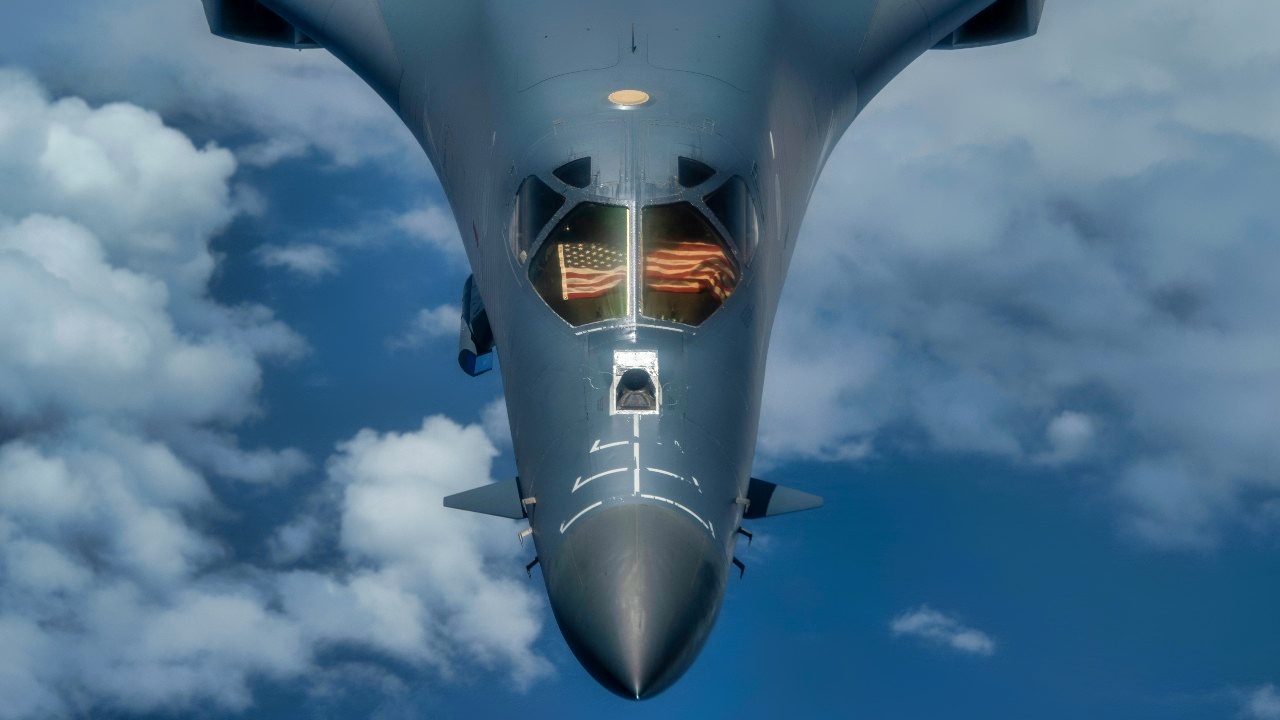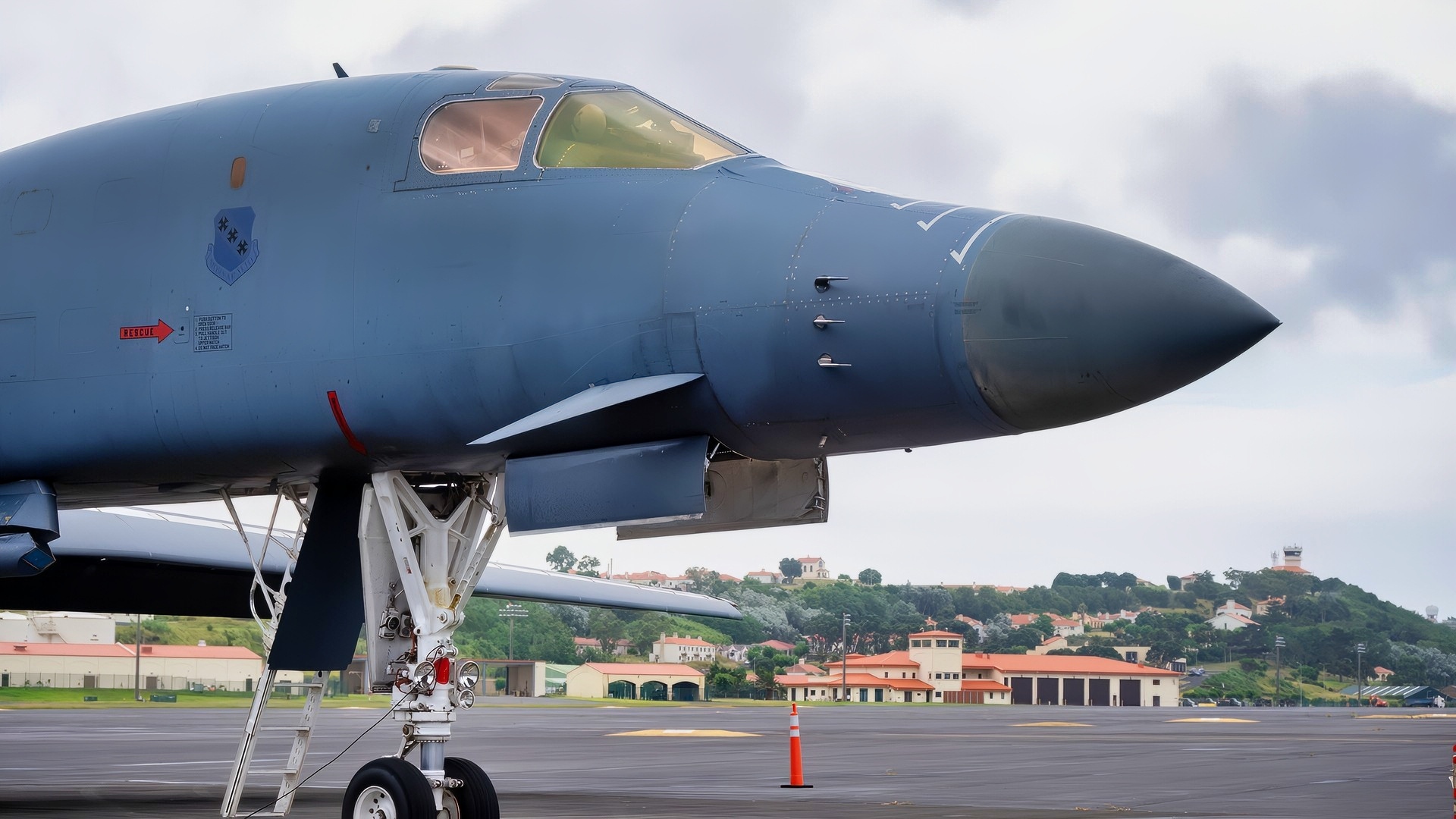Key Points and Summary – Last year, the Air Force pulled B-1B 86-0115 “Rage” out of the Arizona boneyard, swapping it in for 86-0126 “Hungry Devil,” whose deep structural repairs proved costlier and slower than reviving a stored jet.
-It follows the earlier return of “Lancelot” and could be joined by another after a 2024 crash—part of a broader push to keep at least 92 bombers mission-ready.

A 9th Expeditionary Bomb Squadron B-1B Lancer flies over the East China Sea May 6, 2020, during a training mission. The 9th EBS is deployed to Andersen Air Force Base, Guam, as part of a Bomber Task Force supporting Pacific Air Forces’ strategic deterrence missions and commitment to the security and stability of the Indo-Pacific region. (U.S. Air Force photo by Senior Airman River Bruce)
-With only 19 B-2s, a still-modernizing B-52 fleet, and B-21s years from mass fielding, the B-1B’s 75,000-lb conventional payload remains uniquely useful despite heavy maintenance demands from decades of low-level strain. Revived Lancers are a stopgap—buying time until the B-21 arrives in real numbers.
The B-1B Boneyard: An Explainer
In July of last year, it was confirmed that the U.A. Air Force was resurrecting another of its B-1B Lancer bombers from the Arizona “Boneyard,” Davis-Monthan Air Force Base.
The latest aircraft to be revived, which had the tail number 86-0115 and nickname Rage, was photographed departing the air force base (AFB) in early July 2024 before heading to Tinker AFB, Oklahoma, for depot maintenance.
Air Force officials confirmed reports from photographers who captured the aircraft being moved, noting that the decision to move the plane from storage was cheaper and quicker than continuing an extensive repair project on a separate aircraft.
The B-1B Lancer Still Has Power
It is no secret that the B-1B fleet is suffering a growing rate of attrition. Rage will replace Hungry Devil (tail number 86-0126), which had been undergoing complex structural repairs at Boeing’s Palmdale facility. Engineers concluded it was more practical to revive a stored jet than attempt a long-term fix on the damaged aircraft. The news follows earlier reports from this year of Lancelot, another B-1 that was brought back into service to replace a Dyess AFB B-1 that was destroyed in a 2022 engine fire.
And another B-1 may soon be pulled from storage, after a January 2024 crash at Ellsworth AFB left another bomber badly damaged.

A U.S. Air Force B-1B Lancer assigned to the 37th Bomb Squadron receives maintenance during Red Flag 24-3 at Nellis Air Force Base, Nev., July 24, 2024. Red Flag is an exercise that provides Airmen and Guardians with the opportunity to work alongside allied air forces in a realistic combat training environment. (U.S. Air Force Photo by Senior Airman Yendi Borjas)
These recoveries are part of a larger pattern. Of the 17 B-1s retired in 2021, the Air Force preserved four in “reclaimable condition.”
Now, those jets are proving to be essential. Lawmakers set a floor of 92 bombers to remain in the operational inventory at all times in the 2021 National Defense Authorization Act, leaving little room for permanent losses – and for the Air Force, resurrecting retired Lancers is arguably their only option, with next-generation bombers on their way but not set to be delivered in significant numbers for some years. Squadrons must be kept at fighting strength until that next generation arrives.
The B-1B’s Lasting Legacy and Revival
The B-1B Lancer was born of the Cold War. It has been canceled, revived, and reshaped into a bomber that has outlived its original mission on multiple occasions. Originally conceived in the 1970s as a nuclear-capable penetrator, the program was first scrapped by the Carter administration before it was revived again in the 1980s during the Reagan presidency.
The aircraft that ultimately emerged was fast, sleek, and able to carry the largest payload of any U.S. bomber in history – and it quickly became a cornerstone of America’s long-range deterrent.
Designed to fly low and fast under Soviet radar, the B-1B could reach speeds of Mach 1.25 and deliver nuclear weapons deep inside enemy territory. But arms control agreements in the 1990s stripped the fleet of its nuclear role, leaving it as a conventional-only platform.
However, far from being sidelined, the aircraft soon found new purpose in several wars that emerged in the wake of the Cold War. From Kosovo to Iraq and Afghanistan, the B-1 became a workhorse of conventional bombing campaigns. In Afghanistan, for example, the B-1 was frequently used in close air support missions thanks to its ability to loiter for hours before releasing precision-guided munitions in support of ground troops.

A U.S. Air Force B-1B Lancer flies in the U.S. Central Command area of operations, Oct. 25, 2019. The bomber flew directly from its home station of Ellsworth Air Force Base, S.D., demonstrating the U.S. Air Force’s ability to rapidly deploy strategic bombers anywhere in the world. U.S. Strategic Command regularly tests and evaluates the readiness of strategic assets to ensure we are able to honor our security commitments. (U.S. Air Force photo by Master Sgt. Joshua L. DeMotts)
Those strengths are what make it the most obvious answer for the U.S. Air Force when faced with gaps in their bomber fleet. A single B-1 can carry more ordnance than any other U.S. bomber – more than the B-2 Spirit. Though it lacks stealth, the Lancer can haul as much as 75,000 lbs of ordnance, while the Spirit’s maximum payload is roughly 40,000 lbs. And, thanks to its swing-wing design, the aircraft offers flexibility
And yet, these same qualities come at a cost, too. Designed for low-level penetration, the airframes of these aircraft have suffered immense structural strain, and decades of wartime use have left many of them fragile and in need of regular and extensive maintenance – even as they are reintegrated into the U.S. Air Force fleet.
Fleet Strains and Why the B-1s Are Coming Back
The decision to bring mothballed B-1Bs back into service reflects a combination of operational necessity and congressional mandate. On the one hand, the Air Force is dealing with an aging and overstretched bomber force – while eagerly awaiting potentially hundreds of new stealthy B-21 Raiders in the decades ahead. On the other, Congress has imposed statutory requirements that leave the service with little flexibility.
The B-52 Stratofortress, though reliable and currently undergoing a $48 billion re-engining program to ensure it remains viable into the 2050s, is not yet fully modernized and cannot cover all mission needs on its own. THe B-2 Spirit fleet, meanwhile, is limited to just 20 aircraft and requires intensive maintenance, making it too small and too costly to serve as the workhouse. And while the B-21 Raider is advancing in testing – with a second aircraft flying this month – only a handful of prototypes exist so far and it will be years before it enters operational service in meaningful numbers.
With all that in mind, the B-1’s conventional payload abilities and overall versatility make it a truly indispensable asset for the Air Force, despite its fragility.
Its deployment can only be described as a stopgap or bridging strategy, whereby the Air Force patches together enough combat-ready aircraft by reviving Lancers and buying time for the arrival of potentially hundreds of B-21 Raiders.
About the Author:
Jack Buckby is a British author, counter-extremism researcher, and journalist based in New York who writes frequently for National Security Journal. Reporting on the U.K., Europe, and the U.S., he works to analyze and understand left-wing and right-wing radicalization, and reports on Western governments’ approaches to the pressing issues of today. His books and research papers explore these themes and propose pragmatic solutions to our increasingly polarized society. His latest book is The Truth Teller: RFK Jr. and the Case for a Post-Partisan Presidency.
More Military
F-15EX Eagle II vs. China Brand New J-35 Fighter: Who Wins a Fight?
The B-21 Raider Has a New Enemy You Likely Never Heard Of
The Navy’s Biggest Nightmare: The Aircraft Carrier Is Obsolete











Teddy Cantell
September 16, 2025 at 9:17 am
I all I have to say is that I hope they don’t even think of retirement until the 2050’s alongside of our b-52’s they are a big part of the USA’s work force, and definitely a big deterrent!!! This boomer is as much a part of this country as is the Constitution it was way ahead of its time, and needs to stay apart of this country until the foreseeable future!! Just say’n!!! 🇺🇸💪🏻😎!!